Byzantine Rite
The Byzantine Rite, also known as the Greek Rite or the Rite of Constantinople, identifies the wide range of cultural, liturgical, and canonical practices that developed in the Eastern Orthodox Church centred in Constantinople.[1]
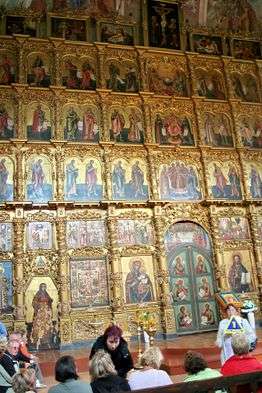
| Part of a series on the |
| Catholic Church |
|---|
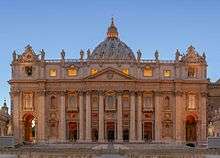 |
| Overview |
|
Miscellaneous
Relations with: |
|
|
The canonical hours are very long and complicated, lasting about eight hours (longer during Great Lent) but are abridged outside of large monasteries.[2] An iconostasis, a partition covered with icons, separates the area around the altar from the nave. There are prominent veneration of icons, a general acceptance of the congregants to freely move within the church and interact with each other in a manner uncommon in Western Christianity, distinctive traditions of liturgical chanting, and the existence of autonomous monastic communities.[note 1]
Traditionally the faithful stand during services, bowing and prostrating frequently; however, this has fallen out of use in many modern churches. Priests, deacons, and monastics always wear a cassock and other clerical garb, even in everyday life (monastics also sleep wearing a cassock), and do not shave or trim their hair or beards.
In addition to numerous psalms read every day, the entire Psalter is read each week, and twice each week during Great Lent, and there are daily readings of other scriptures; also many hymns have quotes from, and references to, the scriptures woven into them. Fasting is stricter than in the modern Western Christianity. On fast days, the faithful abstain from meat and dairy products, and on many fast days also from fish, wine, and the use of oil in cooking. The rite observes four fasting seasons: Great Lent, Nativity Fast, Apostles' Fast and Dormition Fast. In addition, throughout the year most Wednesdays and Fridays, as well as Mondays in monasteries, are fast days.
Neither "Greek" nor "Byzantine" are accepted as descriptors within the Eastern Orthodox Church itself, which does not identify its own often divergent forms of worship as a singular rite. The term "rite" was, rather, created to differentiate the practices of Greek Catholic Churches as a distinct liturgical rite within the wider Catholic Church. Despite the name "Greek Rite", it uses a variety of linguistic traditions, most prominently Slavonic and Georgian, in regions where the Greek language has never been used liturgically, despite being historically associated with the Church of Constantinople.
History
The form of the rite as it presently exists is the product of a long cultural synthesis that developed in the years after the 8th-9th century Iconoclasm, in which synthesis monasteries and their cultural contacts with the Holy Land played a decisive role. From the 9th to the 14th centuries, the influence of the Palestinian Rite[note 2] exerted a dominating influence. The Greek rite has been called a "hybrid"[3] between an earlier ceremonial scholars have dubbed the cathedral rite of Constantinople,[4] called the asmatiki akolouthia ("sung services") and the Palestinian Rite of Jerusalem, the Hagiopolitan (Gr. "of the Holy City") in Greek, chiefly through the monastic typikon of the Mar Saba monastery near Jerusalem. Later developments in the rite were usually connected to monasteries at Constantinople and Mt. Athos patronized by the imperial court, such as Studion, whose Rule formed the nucleus of early monastic communities in Bulgaria and the Rus'.[5] In the early modern period, the traditions of the Byzantine rite received further elaboration from the interface of Christian and Islamic mystical traditions fostered in the Ottoman court.[6]
Before the mid-17th century, the practices of the Muscovite Church, relatively remote from the ecclesiastical centres of Greek and Russian Christianity (the latter historically centred in modern Ukraine), showed significant local and textual variation from the rest of the Christian world. The practices of the Russian Church at large were brought violently in line with the mainstream Greek Rite during the reforms of Patriarch Nikon, resulting in relative uniformity across the Eastern Orthodox Church. The resulting Raskol (Rus. schism) split Russian Christianity into the present Russian Orthodox and the historically persecuted Old Believers, who maintained many archaic practices of worship.[7] As it is presently understood, the term Greek Rite includes both Greek- and Slavonic-speaking traditions, notwithstanding local variation.
The history of the Greek Catholic Church, which first defined a Greek Rite within Western Christianity, is bound up with the emergence of Lithuania, later merged into Poland-Lithuania, as a Catholic state that conquered the predominantly Orthodox lands of the Rus' in Eastern Europe. What was historically called the Uniate Church was set up to accommodate the local Christians and their ecclesiastic leadership under the Catholic umbrella in a state known for its religious tolerance.[8] At the time, the religious boundaries of the Schism were comparatively fluid, and the leadership of what is now western Ukraine had from the 13th to the 15th centuries repeatedly vacillated between eastern and western leadership. The Union of Brest in 1595 finalized the shift of the Orthodox leadership of the lands of White and Little Russia (modern Belarus and Ukraine) to Uniate status. The population of those countries became Greek Catholic without a break in administration. Later, when Muscovite Russia conquered the same, the ecclesiastical leadership largely switched its allegiance again.[9] The modern Ukrainian, Ruthenian, and Hungarian[note 3] Greek Catholic Churches (approx. 5 million total) compose the great majority of Greek Catholics today, but are only a fraction of the early modern Greek Catholic or Uniate population.
The last Greek Catholic congregation of any size, the Arabic-speaking Melkite Greek Catholic Church (approx. 1.5 million), predominantly resident in Syria and with a large diaspora, is descended from a split within the still much more numerous Eastern Orthodox Patriarchate of Antioch (approx. 4.3 million), when in 1729 a claimant to the Antiochene See, removed from his position by the Ottoman authorities, was recognised by the Papacy as the legitimate incumbent. The Melkite Patriarch is presently resident in Damascus, having fled the city of Antioch upon its annexation by Turkey in 1939, a claim disputed by Syria.
The Greek Rite is distinct from other Eastern Rites used by particular churches within the Catholic Church, themselves using the Aramaic-Syriac, Armenian, and Coptic liturgies of the Oriental Orthodox churches that separated from both Greek and Latin worlds before the Great Schism.
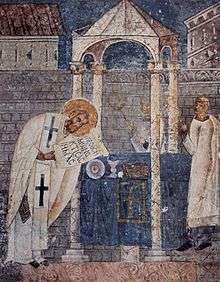
Sacred Mysteries
The Greek Rite maintains a distinctive understanding of the eucharistic service, called the divine liturgy, and what it calls the sacred mysteries - a broad theological category including the seven sacraments defined in the Western Church - that differs slightly from that prevalent in the West, stressing their ineffable character and not marked by the advent of intense theological definition of the centuries after the Reformation.[10] Although all modern Orthodox churches customarily observe the same seven sacraments as in Catholicism, the number has no dogmatic significance, and up to the 17th century individual authors varied greatly in the number of rites considered "mysteries".[11] Despite the historical differences, modern Orthodox and Catholic faithful of both rites are generally united in handling the seven sacraments and the looser number of sacred mysteries, seven only by convention, as effectively equivalent.[12] Greek Catholicism regards the two as identical.[13]
Divine Liturgy
The divine liturgy is normally not celebrated daily except in cathedrals and larger monasteries. However, most parishes and smaller monasteries serve the Liturgy on Saturdays, Sundays, and major feast days throughout the year. When a bishop officiates, the divine liturgy has an expanded form with particular solemnity, even more so than other services. There are several forms of the eucharistic service, three of which are in use universal usage: the liturgy of St. Basil the Great, the Liturgy of St. John Chrysostom, and the Liturgy of the Presanctified Gifts.
- The Liturgy of St. John Chrysostom is the one most commonly celebrated throughout the year.
- The Liturgy of St. Basil is celebrated ten times a year: on the five Sundays in Great Lent, with Vespers on Holy Thursday and Holy Saturday, on the Eves with Vespers (or Feasts themselves, at the normal time, depending on the day of the week) of Christmas and Theophany, and on January 1, which is the feast day of St. Basil.
- The Liturgy of the Presanctified Gifts (which has no Consecration of the Gifts but distributes the Holy Mysteries from a Lamb sanctified in advance, is celebrated as a Vespers (Liturgies on fast days always being served in conjunction with the office of vespers) only on certain weekdays of Great Lent: on Wednesdays, Fridays, and any of the more important feast days which may occur. (But, if the Great Feast of the Annunciation occurs on a weekday of Great Lent, the Divine Liturgy of St. John Chrysostom is celebrated). It is also celebrated on the first three days of Holy Week.
The tradition of the Church of Constantinople ascribes the older of its two main Divine Liturgies to St. Basil the Great (d. 379 AD), Metropolitan of Cæsarea in Cappadocia. This is confirmed by the witness of several ancient authors, some of whom were contemporaries.[14][15][16] It is certain that St. Basil reformed the Liturgy of his Church, and that the Byzantine service named for him represents his reformed Liturgy in its chief parts. It has undergone further modification since his time.[2] St. Basil wrote several accounts of the changes he made in the services of Cæsarea.[17][18] and other contemporary witnesses attest to his arrangement of the services. Basil intended to streamline the services to make them more cohesive and attractive to the faithful. He also worked to reform the clergy and improve the moral life of Christians. He shortened the services and wrote a number of new prayers. The most important work attributed to him is the Divine Liturgy of St. Basil. He took as his basis the Liturgy of St. James, as it was celebrated at his time in the region of Cappadocia, as well as some liturgical elements recorded in the Apostolic Constitutions.[2]
Over time, the Liturgy of Saint Basil gained wide usage in Asia Minor and Syria. Peter the Deacon mentions that Basil's Liturgy was "used by nearly the whole East".[2] But the Alexandrian rite of Coptic Christians uses another Liturgy, which is also attributed to Saint Basil,[19] Peter the Deacon's reference may not be to the Liturgy of St. Basil used in the Byzantine Rite. Saint Basil's liturgical work was continued by John Chrysostom, Archbishop of Constantinople (died c. 407), who wrote new (and shorter) prayers for the Divine Liturgy, as well as other prayers. Today his version of the divine liturgy the standard form used throughout the year.
Daily office
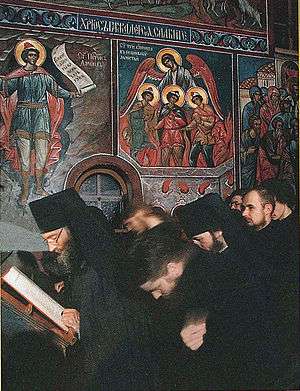
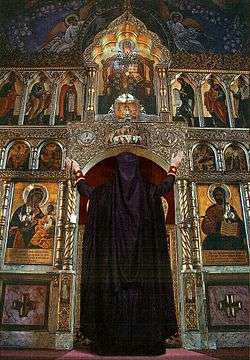
The daily cycle begins with vespers and proceeds throughout the night and day according to the following table:[note 4]
| Name of service in Greek | Name of service in English | Historical Time of service | Theme[note 5] |
|---|---|---|---|
| Esperinos (Ἑσπερινός) | Vespers | At sunset | Glorification of God, the Creator of the world and its Providence |
| Apodipnon (Ἀπόδειπνον) | Compline | At bedtime | Sleep as the image of death, illumined by Christ’s Harrowing of Hell after His death |
| Mesonyktikon (Μεσονυκτικόν) | Midnight Office | At midnight | Christ’s midnight prayer in Gethsemane; a reminder to be ready for the Bridegroom coming at midnight and the Last Judgment |
| Orthros (Ὄρθρος) | Matins or Orthros | Morning watches, ending at dawn | The Lord having given us not only daylight but spiritual light, Christ the Savior |
| Proti Ora (Πρώτη Ὥρα) | First Hour (Prime) | At ≈7 AM | Christ's being brought before Pilate. |
| Triti Ora (Τρίτη Ὥρα) | Third Hour (Terce) | At ≈9 AM | Pilate's judgement of Christ and the descent of the Holy Spirit at Pentecost, which happened at this hour. |
| Ekti Ora (Ἕκτη Ὥρα) | Sixth Hour (Sext) | At noon | Christ's crucifixion, which happened at this hour. |
| Enati Ora (Ἐνάτη Ὥρα) | Ninth Hour (None) | At ≈3 PM | Christ's death, which happened at this hour. |
| Typica (τυπικά) or Pro-Liturgy[note 6] | Typica | follows the sixth or ninth hour | . |
The typica is used whenever the divine liturgy is not celebrated at its usual time, i.e., when there is a vesperal liturgy or no liturgy at all. On days when the liturgy may be celebrated at its usual hour, the typica follows the sixth hour (or matins, where the custom is to serve the Liturgy then) and the Epistle and Gospel readings for the day are read therein;[note 7] otherwise, on aliturgical days or when the Liturgy is served at vespers, the typica has a much shorter form and is served between the ninth hour and vespers.[note 8]
Also, there are Inter-Hours for the First, Third, Sixth and Ninth Hours. These are services of a similar structure to, but briefer than, the hours. Their usage varies with local custom, but generally they are used only during the Nativity Fast, Apostles Fast, and Dormition Fast on days when the Lenten alleluia replaces "God is the Lord" at matins, which may be done at the discretion of the ecclesiarch when the Divine Liturgy is not celebrated.
In addition to these public prayers, there are also private prayers prescribed for both monastics and laypersons; in some monasteries, however, these are read in church. These include Morning and Evening Prayers and prayers (and, in Russia, canons) to be prayed in preparation for receiving the Eucharist.
The full cycle of services are usually served only in monasteries, cathedrals, and other Katholika (sobors). In monasteries and parishes of the Russian tradition, the Third and Sixth Hours are read during the Prothesis ( Liturgy of Preparation); otherwise, the Prothesis is served during matins, the final portion of which is omitted, the Liturgy of the Catechumens beginning immediately after the troparion following the Great Doxology.
The Midnight Office is seldom served in parish churches, except at the Paschal Vigil as the essential office, wherein the burial shroud is removed from the tomb and carried to the altar.
Aggregates
The sundry Canonical Hours are, in practice, grouped together into aggregates[note 9] so that there are three major times of prayer a day: Evening, Morning and Midday.[note 10]
The most common groupings are as follows:
Ordinary days
- Evening — Ninth Hour, Vespers, Compline[note 11]
- Morning Watches — Midnight Office,[note 12] Matins, First Hour
- Morning — Third Hour, Sixth Hour, and the Divine Liturgy or Typica[note 13]
Weekdays during Lent
- Evening — Great Compline
- Morning Watches — Midnight Office, Matins, First Hour
- Morning — Third Hour, Sixth Hour, Ninth Hour, Typica, Vespers (sometimes with the Liturgy of the Presanctified Gifts or, on the Annunciation, the Liturgy of Saint John Chrysostom)
When there is an all-night vigil
On the eves before Great Feasts and, in some traditions, on all Sundays, this grouping is used. However, the All-night vigil is usually abridged so as to not last literally "all-night" and may be as short as two hours; on the other hand, on Athos and in the very traditional monastic institutions, that service followed by the hours and Liturgy may last as long as 18 hours.
When the royal hours are read
- Evening — Ninth Hour, Vespers, Compline
- Morning Watches — Midnight Office, Matins
- Morning — First, Third, Sixth, and Ninth Hours and the Typica
On the eves of Christmas, Theophany, and Annunciation
When the feast is a weekday (or, in the Russian tradition, on any day for Christmas, Theophany), Vespers (with the Liturgy in most instances) is served earlier in the day and so Great Compline functions much as Great vespers does on the vigils of other feast days.
- Evening — Great Compline (in some traditions) and, if there be an All-Night Vigil, the reading, matins, first hour.
- Morning Watches — (unless there be an all-night vigil) midnight office, matins, first hour.
Sacraments and other services performed as needed
The Holy Mysteries (Sacraments)
Baptism
Baptism transforms the old and sinful person into a new and pure one; the old life, the sins, any mistakes made are gone and a clean slate is given. Through Baptism a person is united to the Body of Christ by becoming a member of the Orthodox Church. During the service, water is blessed. The catechumen is fully immersed in the water three times, once in the name of each of the figures of the Holy Trinity. This is considered to be a death of the "old man" by participation in the crucifixion and burial of Christ, and a rebirth into new life in Christ by participation in his resurrection.[20] Properly a new name is given, which becomes the person's name.
Children of Orthodox families are normally baptized shortly after birth. Converts to Orthodoxy are usually formally baptized into the Orthodox Church, though exceptions are sometimes made. Those who have left Orthodoxy and adopted a new religion, if they return to their Orthodox roots, are usually received back into the church through the mystery of Chrismation.
Properly, the mystery of Baptism is administered by bishops and priests; however, in emergencies any Orthodox Christian can baptize.[21] In such cases, should the person survive the emergency, it is likely that the person will be properly baptized by a priest at some later date. This is not considered to be a second baptism, nor is it imagined that the person is not already Orthodox, but rather it is a fulfillment of the proper form.
The service of Baptism used in Orthodox churches has remained largely unchanged for more than 1500 years. St. Cyril of Jerusalem (d. 386), in his Discourse on the Sacrament of Baptism, describes the service; it is largely onsistent with the service currently in use in the early 21st century.
Chrismation
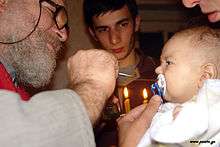
Chrismation grants the gift of the Holy Spirit through anointing with Holy Chrism.[22] It is normally given immediately after baptism as part of the same service. It may also be used to formally receive again lapsed members of the Orthodox Church.[23] As baptism is a person's participation in the death and resurrection of Christ, so chrismation is a person's participation in the coming of the Holy Spirit at Pentecost.[24]
A baptized and chrismated Orthodox Christian is a full member of the Church and may receive the Eucharist regardless of age[24] and, indeed, does so beginning at the first liturgy attended after chrismation, infant communion being the universal norm.
The sanctification of chrism may, in theory, be performed by any bishop at any time, but in longstanding practice is performed no more than once a year by hierarchs of most of the autocephalous churches, although some autocephalous churches obtain their chrism from another church. Anointing with it substitutes for the laying-on of hands described in the New Testament, and according to the prayer of consecration of chrism, the apostles made the initial chrism, laying their hands on it, for priests to substitute for laying on of hands for sundry practices, where only the apostles could perform said laying on of hands.[25]
Holy Communion (Eucharist)
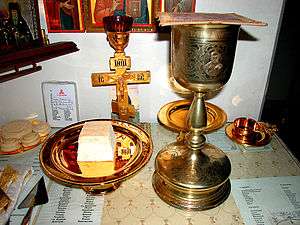
The Eucharist is at the center of Orthodox Christianity. In practice, it is the partaking of the Body and Blood of Jesus Christ in the midst of the Divine Liturgy with the rest of the church. The bread and wine are believed to be transubstantiated as the genuine Body and Blood of the Christ Jesus through the operation of the Holy Spirit.
Communion is given only to baptized Orthodox Christians who have prepared by fasting, prayer and confession. The wine is administered with a spoon directly into the recipient's mouth from the chalice.[26] From baptism young infants and children are carried to the chalice to receive holy communion.[24]
Because of the Orthodox understanding of mankind's fallen nature in general, those who wish to commune prepare themselves in a way that reflects mankind in paradise. First, they prepare by having their confession heard and the prayer of repentance read over them by a priest. They are encouraged to increase their prayer rule, adding the prescribed prayers in preparation for communing. Finally, they fast completely from food, drink, and sexual activity from the evening before, a time interpreted variously in sundry locations as: from arising from sleep, or from midnight, or from sunset the previous evening.
Confession
When one who has committed sins repents of them, wishing to reconcile to God and renew the purity of original baptisms, they confess their sins to God before a spiritual guide who offers advice and direction to assist the individual in overcoming their sin. Parish priests commonly function as spiritual guides, but such guides can be any person, male or female, who has been given a blessing to hear confessions. Spiritual guides are chosen very carefully, as this is a mandate that once chosen must be obeyed. Having confessed, the priest lays his hands on the penitent's head while reciting the prayer of absolution.
Sin is a mistake made by the individual, but there is the opportunity for spiritual growth and development. An act of Penance (epitemia), if the spiritual guide requires it, is never formulaic, but rather is directed toward the individual and their particular problem, as a means of establishing a deeper understanding of the mistake made, and how to effect its cure. Because full participatory membership is granted to infants, it is not unusual for even small children to confess. Though the scope of their culpability is far less than an older child, they also have an opportunity for spiritual growth.
Marriage
.jpg)
From the Orthodox perspective, marriage is one of the holy mysteries or sacraments. As well as in many other Christian traditions, for example in the Roman Catholic Church, it serves to unite a woman and a man in eternal union and love before God, with the purpose of following Christ and His Gospel and raising up a faithful, holy family through their holy union.[27][28] The church understands marriage to be the union of one man and one woman, and certain Orthodox leaders have spoken out strongly in opposition to the civil institution of same-sex marriage.[29][30]
Jesus said that "when they rise from the dead, they neither marry nor are given in marriage, but are like angels in heaven" (Mk 12:25). For the Orthodox Christian this passage should not be understood to imply that Christian marriage will not remain a reality in the Kingdom, but points to the fact that relations will not be "fleshy", but "spiritual".[28] Love between wife and husband, as an icon of relationship between Christ and Church, is eternal.[28]
The Church does recognize that there are rare occasions when it is better that couples do separate, but there is no official recognition of civil divorces. For the Orthodox, to say that marriage is indissoluble means that it should not be broken, the violation of such a union, perceived as holy, being an offense resulting from either adultery or the prolonged absence of one of the partners. Thus, permitting remarriage is an act of compassion of the Church towards sinful man.[31] Ecclesiastically divorced Orthodox (not civilly divorced only).
Widowed people, as well as divorcées, may remarry, but a different, penitential service is used, and there is usually imposed on them a fairly severe penance by their bishop and the services for a second marriage in this case are more penitential than joyful.
Deacons and priests, however, may not remarry or, if he does, he is liaised.
Should a married deacon or priest die, it is common for his wife to retire to a monastery once their children are out of the house. Widowed priests are not allowed to remarry (no priest may be married after his ordination) and also frequently end up in monasteries.
The service of a first Marriage in the Orthodox Church has two distinct parts: the Betrothal and the Crowning. There is no exchange of vows. There is a set expectation of the obligations incumbent on a married couple, and whatever promises they may have privately to each other are their responsibility to keep.
The service of a remarriage is penitential.
Holy Orders
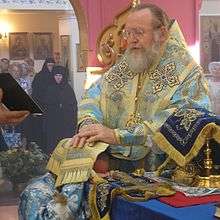
Since its founding, the Church spread to different places and its leaders in each region came to be known as episkopoi (overseers, plural of episkopos, overseer—Gr. ἐπίσκοπος), which became "bishop" in English. The other ordained roles are presbyter (Gr. πρεσβύτερος, elder), which became "prester" and then "priest" in English, and diakonos (Gr. διάκονος, servant), which became "deacon" in English (see also subdeacon). There are numerous administrative positions among the clergy that carry additional titles.
Bishops are always monks. Although someone who is not a monk may be elected to be a bishop, which frequently happens with widowed priests, he must receive a monastic tonsure before consecration to the episcopate. Deacons and priests, however, are typically married, and it is customary that only monks or married men be ordained. It is considered preferable for parish priests to be married as they often act as counsel to married couples and thus can draw on their own experience. Unmarried priests usually are monks and live in monasteries, though when there is of a shortage of married priests, a monk-priest may be assigned to a parish.
A deacon or priest would have to abandon his orders, i.e., be liaised, to marry after ordination; it is common for widowed clergy to enter a monastery. Also, widowed wives of clergy, who are discouraged from remarrying, often become nuns when their children are grown.
Only men can take holy orders, although deaconesses had both liturgical and pastoral functions within the church.[32] This has fallen out of practice, the last deaconess having been ordained in the 19th century; however, in 2016, Greek Orthodox Church of Alexandria decided to reinstate the order of deaconesses and, in February 2017, Patriarch Theodoros II appointed six nuns to be subdeacons.[33]
Unction
Anointing with oil, often called "unction", is one of the mysteries administered by the Orthodox Church and it is not reserved only for the dying or terminally ill, but for all in need of spiritual or bodily healing, and with reception of this sacrament comes forgiveness of sins. In Greece, during the Ottoman occupation, when parish priests were not allowed to hear confessions, it became the custom to administer this mystery annually on Great Wednesday to all believers so that all could commune the following days through Pascha. In recent decades, this custom has spread to many other locations.
Other services performed as needed
Local variations
Two main strata exist in the rite, those places that have inherited the traditions of the Russian Church which had been given only the monastic Sabbaite typicon which she uses to this day[note 16] in parishes and cathedrals as well as in monasteries, and everywhere else where some remnant of the cathedral rite remained in use; therefore, the rite as practiced in monasteries everywhere resembles the Russian recension, while non-Russian non-monastic customs differs significantly. For example, in the Russian tradition, the "all-night vigil" is served in every church on Saturday nights and the eves of feast days (although it may be abridged to be as short as two hours) while elsewhere, it is usual to have matins on the morning of the feast; however, in the latter instance, vespers and matins are rather less abridged but the Divine Liturgy commences at the end of matins and the hours are not read, as was the case in the extinct cathedral rite of Constantinople.
Also, as the rite evolved in sundry places, different customs arose; an essay on some of these has been written by Archbishop Basil Krivoshein and is posted on the web.[34]
Liturgical books
Horologion (Ὡρολόγιον; Church Slavonic: Chasoslov, Часocлoвъ), or Book of Hours, provides the fixed portions of the Daily Cycle of services (Greek: ἀκολουθίαι, translit. akolouthiai) as used by the Eastern Orthodox and Eastern Catholic churches.
Into this fixed framework, numerous moveable parts of the service are inserted. These are taken from a variety of liturgical books:
- Psalter (Greek: Ψαλτήρ(ιον), Psalter(ion); Slavonic: Ѱалтырь or Ѱалтирь, Psaltyr' ) A book containing the 150 Psalms[note 17] divided into 20 sections called Kathismata together with the 9 Biblical canticles which are chanted at Matins; although these canticles had been chanted in their entirety, having over time come to be supplemented by interspersed hymns (analogously to stichera) to form the Canon, the canticles themselves are now only regularly used in a few large monasteries[note 18] The Psalter also contains the various "selected psalms", each composed of verses from a variety of psalms, sung at matins on feast days, as well as tables for determining which Kathismata are to be read at each service; in addition to the Psalms read at the daily offices, all the Psalms are read each week and, during Great Lent, twice a week.
- Octoechos (Greek: Ὀκτώηχος; Slavonic: Октоихъ, Oktoikh or Осмогласникъ, Osmoglasnik)—Literally, the Book of the "Eight Tones" or modes. This book contains a cycle of eight weeks, one for each of the eight echoi (church modes of the Byzantine musical system of eight modes), providing texts for each day of the week for Vespers, Matins, Compline, and (on Sundays) the Midnight Office. The origins of this book go back to compositions by St. John Damascene. The (Great) Octoechos is also called "Parakletike". Octoechoi containing only Marianic hymns are called "Theotokarion". Since the 17th century different collections of the Octoechos had been separated as own books about certain Hesperinos psalms like the Anoixantarion an octoechos collection for the psalm 103, the Kekragarion for psalm 140, and the Pasapnoarion for the psalm verse 150:6 and also the Doxastarion.[35]
- Menaion (Greek: Μηναῖον; Slavonic: Минїѧ, Miniya)—A twelve-volume set which provides liturgical texts for each day of the calendar year,[note 19] printed as 12 volumes, one for each month of the year.[note 20] Another volume, the General Menaion contains propers for each class of saints for use when the propers for a particular saint are not available. Additionally, locally venerated saints may have services in supplemental volumes, pamphlets, or manuscripts.
- Menologion (Greek: Μηνολόγιον) A collection of the lives of the saints and commentaries on the meaning of feasts for each day of the calendar year, also printed as 12 volumes,[note 20] appointed to be read at the meal in monasteries and, when there is an all-night vigil for a feast day, between vespers and matins.
- Triodion (Greek: Τριῴδιον, Triodion; Slavonic: Постнаѧ Трїωдь, Postnaya Triod' ; Romanian: Triodul), also called the Lenten Triodion. The Lenten Triodion contains propers for:
- the Pre-Lenten Season
- the Forty Days of Great Lent itself
- Lazarus Saturday and Palm Sunday
- Holy Week
- Pentecostarion (Greek: Πεντηκοστάριον, Pentekostarion; Slavonic: Цвѣтнаѧ Трїωдь, Tsvetnaya Triod' , literally "Flowery Triodon"; Romanian: Penticostar) This volume contains the propers for the period from Pascha to the Sunday of All Saints. This period can be broken down into the following periods:
- Bright Week (Easter Week) Commencing with matins on Pascha (Easter Sunday) through the following Saturday
- Paschal Season—The period from Thomas Sunday until Ascension
- Ascension and its Afterfeast
- Pentecost and its Afterfeast
- All Saints Sunday (the Sunday after Pentecost)
- Synaxarion (Greek: Συναξάριον; Romanian: Sinaxar)—The Synaxarion contains for each day of the year brief lives of the saints and meanings of celebrated feasts, appointed to be read after the Kontakion and Oikos at Matins.
- Irmologion (Greek: Εἱρμολόγιον; Slavonic: Ирмологий, Irmologii)—Contains the Irmoi chanted at the Canon of Matins and other services. The hymns of the books heirmologion and octoechos had been collected earlier in a book called "Troparologion" or "Tropologion".
- Priest's Service Book (Greek: Ἱερατικόν, Ieratikon; Slavonic: Слѹжебникъ, Sluzhebnik) It contains the portions of the services which are said by the priest and deacon and is given to a deacon and to a priest with his vestments at ordination.[note 21] The Mega Euchologion contains the portions of the services for the whole year which are said by the priest (Hieratikon), the bishop (Archieratikon) or the deacon (Hierodiakonikon). The two largest parts are the Litourgikon with the liturgies for the whole year and the Hagiasmatarion with the blessings.
- Bishop's Service Book (Greek: Ἀρχιερατικόν Archieratikon, Slavonic: Чиновникъ, Chinovnik) the portions of the services which are said by the Bishop; for the Canonical Hours, this differs little from what is in the Priest's Service Book.
- Prophetologion (Greek: Προφητολόγιον) It contains the Old Testament Lectionary readings appointed at Vespers and at other services during the Church year.
- Gospel Book (Greek: Εὐαγγέλιον, Evangelion or Εὐαγγελιστάριον, Evangelistarion) Book containing the 4 Gospels laid out as read at the divine services.[note 22]
- Apostle Book (Greek: Ἀπόστολος or Πραξαπόστολος, Apostolos or Praxapostolos; Slavonic: Апостолъ, Apostol) Contains the readings for the Divine Liturgy from the Acts of the Apostles and the Epistles together with the Prokeimenon and Alleluia verses that are chanted with the readings.[note 22]
- Patristic writings Many writings from the Church fathers are prescribed to be read at matins and, during great lent, at the hours; in practice, this is only done in some monasteries and frequently therein the abbot prescribes readings other than those in the written rubrics. Therefore, it is not customary to enumerate all the volumes required for this.
- Collections (Greek: Ἀνθολόγιον, Anthologion; Slavonic: Сборникъ, Sbornik) There are numerous smaller anthologies available[note 23] which were quite common before the invention of printing but still are in common use both because of the enormous volume of a full set of liturgical texts and because the full texts have not yet been translated into several languages currently in use. Some of the anthologies are called Hymnologion.
- Typicon (Greek: Τυπικόν, Typikon; Slavonic: Тѵпико́нъ, Typikon or уста́въ, ustav) Contains all of the rules for the performance of the Divine Services, giving directions for every possible combination of the materials from the books mentioned above into the Daily Cycle of Services.
- Anastasimatarion (Greek: Ἀναστασιματάριον) is a service book that contains the Anastasima (Resurrectional) hymns of vespers, Sunday matins and other hymns.
- Sticherarion (Greek: Στιχηράριον) it contains the stichera for the morning and evening services throughout the year. Chant compositions in the sticheraric melos can also be found in other liturgical books like the Octoechos or the Anastasimatarion.
- Hebdomadarion (Greek: Ἑβδομαδάριον) is a liturgical book which contains the Paracletical canons of the week.
- Homilies (Greek: Ὁμιλίαι) some homilies of the Church Fathers are recited regularly or on special occasions, such as the Paschal Homily of St. John Chrysostom.
Also some books for special occasions, such as the book for the great week- He Megale Ebdomas, the Dekapentaugoustarion for the 15. August, or the Eklogadion including certain excerpts. The Apostolike Diakonia of the Church of Greece and some Greek-orthodox bishops have also published certain old liturgies. Such as the Liturgy of St. James and other.
Calendar
The fixed portion of the liturgical year begins on September 1. There is also a moveable Paschal cycle which is fixed according to the date of Pascha (Easter), by far the most important day of the entire year. The interplay of these two cycles, plus other lesser cycles influences the manner in which the services are celebrated on a day to day level throughout the entire year.
Traditionally, the Julian Calendar has been used to calculate feast days. Beginning in 1924, several autocephalous churches adopted, for fixed dates, the Revised Julian Calendar which is aligned with the Gregorian calendar; the Paschal cycle, however, continued to be calculated according to the Julian Calendar. Today, some churches and portions of some other churches continue to follow the Julian Calendar while others follow the Revised Julian (Eastern Orthodox) or Gregorian (usually the more Latinized Byzantine Catholic) Calendar. Among Eastern Orthodox, only the Orthodox Church of Finland has adopted the Western calculation of the date of Pascha (see computus); all other Orthodox Churches, and a number of Eastern Catholic Churches, as well as the Ukrainian Lutheran Church, celebrate Pascha according to the ancient rules.[36]
Liturgical cycles
Various cycles of the liturgical year influence the manner in which the materials from the liturgical books (above) are inserted into the daily services:
Weekly cycle
Each day of the week has its own commemoration:
- Sunday—Resurrection of Christ
- Monday—The Holy Angels
- Tuesday—St. John the Forerunner
- Wednesday—The Cross and the Theotokos
- Thursday—The Holy Apostles and St. Nicholas
- Friday—The Cross
- Saturday—All Saints[note 24] and the departed
Most of the texts come from the Octoechos, which has a large collections of hymns for each weekday for each of the eight tones; during great lent and, to a lesser degree, the pre-lenten season, the Lenten Triodion supplements this with hymns for each day of the week for each week of that season, as does the Pentecostarion during the pascal season. Also, there are fixed texts for each day of the week are in the Horologion and Priest's Service Book (e.g., dismissals) and the Kathismata (selections from the Psalter) are governed by the weekly cycle in conjunction with the season.
Fixed cycle
Commemorations on the Fixed Cycle depend upon the day of the calendar year, and also, occasionally, specific days of the week that fall near specific calendar dates, e.g., the Sunday before the Exaltation of the Cross. The texts for this cycle are found in the Menaion.
Paschal cycle
The commemorations on the Paschal Cycle (Moveable Cycle) depend upon the date of Pascha (Easter). The texts for this cycle are found in the Lenten Triodion, the Pentecostarion, the Octoechos and also, because the daily Epistle and Gospel readings are determined by this cycle, the Gospel Book and Apostle Book. The cycle of the Octoechos continues through the following great lent, so the variable parts of the lenten services are determined by both the preceding year's and the current year's dates of Easter.
8 Week cycle of the octoechos
The cycle of the eight Tones is found in the Octoechos and is dependent on the date of Easter and commences with the Sunday after (eighth day of) Easter, that week using the first tone, the next week using the second tone, and so, repeating through the week preceding the subsequent Palm Sunday.[note 25]
11 Week cycle of the matins gospels
The portions of each of the Gospels from the narration of the Resurrection through the end are divided into eleven readings which are read on successive Sundays at matins; there are hymns sung at Matins that correspond with that day's Matins Gospel.
List of Churches of Byzantine liturgical tradition
Eastern Orthodox Churches

- Only autocephalous (self-governed) churches are listed; autonomous churches are considered under their mother churches. Those churches which continue to follow the old Julian Calendar are marked with an asterisk (*), while those that follow the Revised Julian Calendar are unmarked.
- Ecumenical Patriarchate of Constantinople
- Greek Orthodox Church
- Greek Orthodox Church of Alexandria
- Greek Orthodox Church of Antioch
- Greek Orthodox Church of Jerusalem*
- Russian Orthodox Church*
- Serbian Orthodox Church*
- Romanian Orthodox Church
- Bulgarian Orthodox Church
- Georgian Orthodox Church*
- Cypriot Orthodox Church
- Church of Greece
- Albanian Orthodox Church
- Polish Orthodox Church*
- Czech and Slovak Orthodox Church*
- Orthodox Church in America
Greek-Catholic Churches
| Part of a series on |
| Particular churches sui iuris of the Catholic Church |
|---|
Latin cross and Byzantine Patriarchal cross |
| Particular churches are grouped by rite. |
| Alexandrian Rite |
| Armenian Rite |
| Byzantine Rite |
| East Syriac Rite |
| Latin liturgical rites |
| West Syriac Rite |
|
|
- These Particular Churches are considered sui iuris churches (autonomous) in full communion with the Holy See
- Albanian Greek Catholic Church
- Belarusian Greek Catholic Church
- Bulgarian Greek Catholic Church
- Byzantine Catholic Church of Croatia and Serbia
- Greek Byzantine Catholic Church
- Melkite Greek Catholic Church
- Hungarian Greek Catholic Church
- Italo-Albanian Catholic Church
- Macedonian Greek Catholic Church
- Romanian Church United with Rome, Greek-Catholic
- Russian Greek Catholic Church
- Ruthenian Greek Catholic Church
- Slovak Greek Catholic Church
- Ukrainian Greek Catholic Church
Note: Georgian Byzantine-Rite Catholics are not recognized as a particular Church (cf. canon 27 of the Code of Canons of the Eastern Churches).
Byzantine Rite Lutheranism
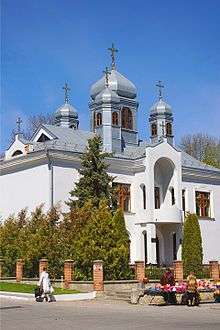
- The Ukrainian Lutheran Church[37] uses liturgical formulae from the Byzantine Rite to form the base text for the Order of Service in the Ukrainian Evangelical Service Book,[38][39] as well as the Julian calendar.[36]
- It has also been used by the German Eastern Rite Community (Ostkirchlicher Konvent), St. Valentine's Lutheran Fellowship of the Grand Canyon Synod (ELCA), and in the Evangelical Lutheran Church of the Augsburg Confession in Slovenia.
- Several other Lutheran communities also use the Byzantine Rite that has been adapted to Lutheran theology.
Society for Eastern Rite Anglicanism
It has also been employed, although less frequently, in the Anglican Communion, e.g., its being utilized by the Society for Eastern Rite Anglicanism.[40]
Notes
- The stance of Greek Catholic theologians on the historically anti-Latin hesychast mysticism that has defined Eastern Orthodox monasticism is sometimes ambivalent. (https://www.mliles.com/melkite/stgregorypalamas.shtml)
- Referring to the Greek Orthodox Church centred in Jerusalem, rather than the Coptic or Antiochene Churches, which were Monophysite.
- The Hungarian Greek Catholic Church itself originated with a branch of the Slavonic-speaking Uniate Church
- In accordance with Old Testament or Jewish practice, the day is considered to begin in the evening (Genesis 1:5).
- Sokolof, pp 36-38
- Sokolof, p 93
- The typica has a certain correspondence to the Missa Sicca of the Mediaeval West.
- Sokolof, p 93
- Sokolof, p 36
- This is to conform with Psalm 55:17, "Evening, morning, and noonday will I tell of it and will declare it, and He will hear my voice."
- In monasteries, when there is an evening meal, compline is often separated from vespers and read after the meal; in Greek (απόδειπνον/apodeipnon) and Slavonic (Повечерiе/Pov'echeriye), the name for Compline literally means, "After-supper."
- Midnight Office is often omitted in parish churches.
- Though the Liturgy (and yypica are not, strictly speaking, a part of the daily cycle of services, their placement is fixed by the Typikon in relation to the daily cycle.
- This is an abbreviated, redundant Vespers
- On great feast days proceeded by a strict fast (Christmas, Epiphany, and Annunciation on a weekday), the Vigil commences with Great Compline rather than Vespers
- Тvпико́нъ сіесть уста́въ (the Typicon which is the Order), p 1
- There is also a Psalm 151 which is often included in the Psalter, though it is not actually chanted during the Divine Services.
- excepting in the Russian tradition where they are used weekly on weekdays of Great Lent.
- On non-leap years, the service for 29 Feb. (St. John Cassian) is sung at compline on 28 Feb..
- The liturgical year begins in September, so the volumes are numbered from 1 for September to 12 for August.
- Originally, the deacon's book and the priest's books were distinct, but upon the invention of printing, it was found more practical to combine them.
- In Greek editions the Evangélion or better Ευαγγελιστάριον is laid out in order of the cycle of readings as they occur in the ecclesiastical year, with a section in the back providing the Gospel readings for Matins, Feasts and special occasions. In the Slavic usage, the Evangélion contains the four gospels in canonical order (Matthew, Mark, Luke, John) with annotations in the margin to indicate the beginning and ending of each reading (and an index in the back).
The Apostól is likewise edited, the Slavonic Apostól having all of the books of the New Testament (excluding the Gospels and Apocalypse) in their entirety, though not in the same order they are found in most English Bibles (Acts is placed first, followed by the Catholic Epistles, etc.). - For instance, the Festal Menaion contains only those portions of the Menaion that have to do with the Great Feasts; and the General Menaion, et cetera.
- Including, especially, the Theotokos and the Patron Saint of the local church or monastery.
- Each day of Bright Week (Easter Week) uses propers in a different tone, Sunday: Tone One, Monday: Tone Two, skipping the grave tone (Tone Seven)
See also
Other Eastern liturgical rites:
References
- "Codex Canonum Ecclesiarum Orientalium, 'Churches Sui Iuris and Rites', Canon 28".
- Fortescue, Adrian (1908), "The Rite of Constantinople", The Catholic Encyclopedia, IV, New York: Robert Appleton Company, retrieved 2007-12-15
- Taft, Robert F. (1992). The Byzantine Rite: A Short History. Collegeville, MN: Liturgical Press. p. 16. ISBN 9780814621639.
- Parenti, Stefano. "The Cathedral Rite of Constantinople: Evolution of a Local Tradition". Cite journal requires
|journal=(help) - "Eastern Orthodoxy - History". Encyclopedia Britannica. Retrieved 2020-04-28.
- Gerlach, Oliver. ""The Heavy Mode (ēchos varys) on the Fret Arak" — Eastern Chant in Istanbul and the Various Influences during the Ottoman Empire". Porphyra 22, 82-95.
- "Old Believer | Russian religious group". Encyclopedia Britannica. Retrieved 2020-04-28.
- Halina Stephan, Living in Translation: Polish Writers in America, Rodopi, 2003, ISBN 90-420-1016-9, Google Print p. 373. Quoting from Sarmatian Review academic journal mission statement: "Polish–Lithuanian Commonwealth was ... characterized by religious tolerance unusual in premodern Europe"
- Ioffe, Grigory (2010-06-03). "Understanding Belarus: Belarussian identity". Europe-Asia Studies. doi:10.1080/0966813032000141105.
- "The Orthodox Faith - Volume II - Worship - The Sacraments - The Sacraments". www.oca.org. Retrieved 2020-04-28.
- "Excerpts from the Orthodox Church by Bishop Kallistos Ware". www.fatheralexander.org. Retrieved 2020-04-28.
- "The Mysteries – Introduction to the Orthodox Church". Retrieved 2020-04-28.
- "Holy Mysteries: The Sacraments in the Tradition of the Byzantine Rite". Archeparchy of Pittsburgh. 2015-12-29. Retrieved 2020-04-28.
- Gregory of Nazianzus, "euchon diataxis -- Oration XX", in Jacques Paul Migne (ed.), Patrologia Graecae, XXXV, 761, Paris: Imprimerie Catholique
- Gregory of Nyssa, "Hierourgia, In laudem fr. Bas.", in Jacques Paul Migne (ed.), Patrologia Graecae, XLVI, 808, Paris: Imprimerie Catholique
- Proclus of Constantinople, "De traditione divinæ Missæ", in Jacques Paul Migne (ed.), Patrologia Graecae, XLV, 849, Paris: Imprimerie Catholique
- Basil of Caesarea, "Epistle CVII", in Jacques Paul Migne (ed.), Patrologia Graecae, XXXII, 763, Paris: Imprimerie Catholique
- Basil of Caesarea, "Oration XX", in Jacques Paul Migne (ed.), Patrologia Graecae, XXXV, 761, Paris: Imprimerie Catholique
- "The Coptic Liturgy (of Saint Basil)." Retrieved 2011-07-08
- Ware 1993, pp. 277-278.
- Ware 1993, p. 278.
- Ware 1993, pp. 278-9.
- Harakas 1987, pp. 56–7.
- Ware 1993, p. 279
- Harakas 1987, p. 57.
- Ware 1993, p. 287.
- Letter to Families by Pope John Paul II Archived April 5, 2011, at the Wayback Machine
- John Meyendorff (1975). Marriage: An Orthodox Perspective. St. Vladimir's Seminary Press. p. 18. ISBN 978-0-913836-05-7. Retrieved 2016-02-20.
- "Statement of Orthodox Christian Bishops" (PDF). Archived from the original (PDF) on 4 August 2010.
- "OCA Reaffirms SCOBA Statement in Wake of Massachusetts Same-Sex Marriage Ruling". Retrieved 4 August 2010.
- Mgr. Athenagoras Peckstadt, Bishop of Sinope (18 May 2005). "Marriage, Divorce and Remarriage in the Orthodox Church: Economia and Pastoral Guidance". The Orthodox research Institute. Retrieved 19 November 2008.
- Karras, Valerie A. (June 2004). "Female Deacons in the Byzantine Church". Church History. 73 (2): 272–316. doi:10.1017/S000964070010928X. ISSN 0009-6407.
- Catherine Clark (2017-03-09). "Orthodox Church debate over women deacons moves one step closer to reality". News — World. National Catholic Reporter. Retrieved 2020-05-16.
- "Some differences between Greek and Russian divine services and their significance by Basil Krivoshein, Archbishop of Brussels and Belgium", retrieved 2012-01-01]
- The separation of this books can usually be found in anthologies ascribed to Panagiotes the New Chrysaphes (GB-Lbl Harley 1613, Harley 5544), but there is also a manuscript with composition of Petros Peloponnesios and his student Petros Byzantios organised as an Anastasimatarion and Doxastarion which preceded the printed editions (GB-Lbl Add. 17718).
- Moroz, Vladimir (10 May 2016). "Лютерани східного обряду: такі є лише в Україні" (in Ukrainian). РІСУ - Релігійно-інформаційна служба України. Retrieved 19 September 2018.
Щодо календаря, то окрім звичних для більшості християн дванадесятих свят в УЛЦ є й особливі. Так, тут знаходимо День народної радості (День Соборності України) – 22 січня; св. Костянтина Острозького – 13 лютого; св. Мартіна Лютера, доктора і сповідника – 18 лютого; св. Лукаса Кранаха і Альбрехта Дюрера, художників – 6 квітня; св. Аскольда, християнського правителя – 4 липня; св. Яна Гуса, пастиря і мученика. 28 липня українські лютерани відзначають спільно празник Св. Володимира Великого, просвітителя Русі-України, християнського правителя, а також Св. Йогана Себастьяна Баха, кантора. Є у календарі УЛЦ і багато святих, яких зазвичай ототожнюють із Католицькою чи Православною Церквою. Це, зокрема, св. Іван Золотоустий, Боніфацій Майнцький, Бернард із Клерво, св. Климент Римський, св. Амвросій Медіоланський, св. Нестор Літописець та багато інших.
- The Ukrainian Lutheran Church is a member of the Confessional Evangelical Lutheran Conference, a communion of 20 Lutheran churches.
- Information about the Ukrainian Lutheran Church
- "The Divine Liturgy of Saint John Chrysostom, used by the Ukrainian Lutheran Church, and its missing elements: OMHKSEA". www.omhksea.org. Retrieved 2016-05-03.
- "Society for Eastern Rite Anglicanism (SERA) |". www.easternanglicanism.org. Retrieved 2016-03-18.
Books
- Robert F. Taft, The Byzantine Rite. A Short History. Liturgical Press, Collegeville 1992, ISBN 0-8146-2163-5
- Hugh Wybrew, The Orthodox Liturgy. The Development of the Eucharistic Liturgy in the Byzantine Rite, SPCK, London 1989, ISBN 0-281-04416-3
- Hans-Joachim Schulz, Die byzantinische Liturgie : Glaubenszeugnis und Symbolgestalt, 3., völlig überarb. und aktualisierte Aufl. Paulinus, Trier 2000, ISBN 3-7902-1405-1
- Robert A. Taft, A History of the Liturgy of St John Chrysostom, Pontificio Istituto Orientale, Roma 1978-2008 (6 volumes).
External links
- Byzantine rite in Italy - the tradition of the Italo-Greek-Albanian Church
- Fr. Ronald Roberson's book The Eastern Christian Churches – A Brief Survey is the most up-to-date primer on these churches, available online at Catholic Near-East Welfare Association (CNEWA).

- Rites of the Catholic Church Giga-catholic website
- Study Text of the Divine Liturgy of Saint John Chrysostom
- Study Text of the Divine Liturgy of Saint Basil the Great
- The Divine Music Project - thousands of pages of Byzantine music in English for Byzantine rite services
- Text of the Union of Brest (translation)
- The Byzantine-Slavic Rite

